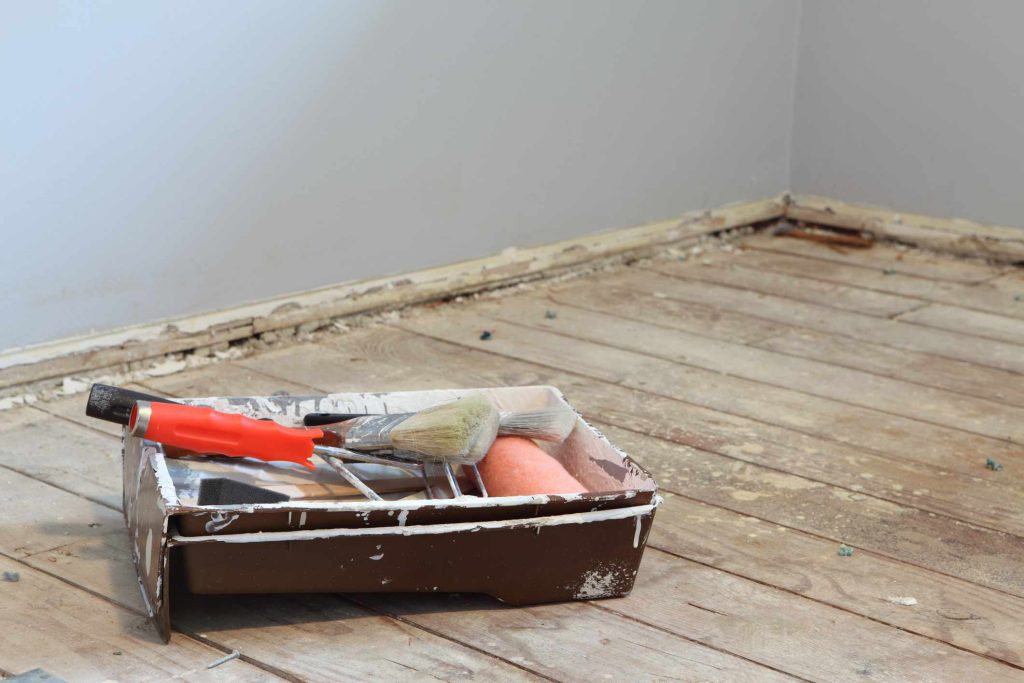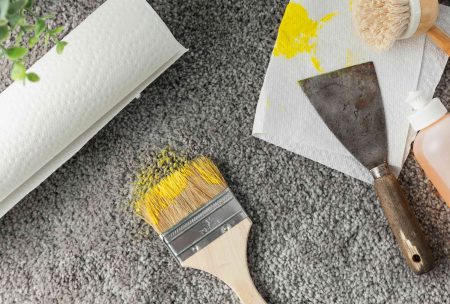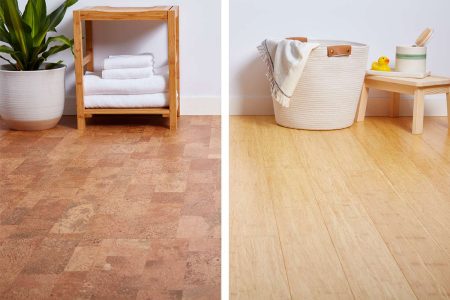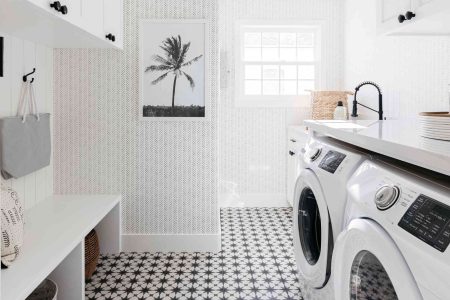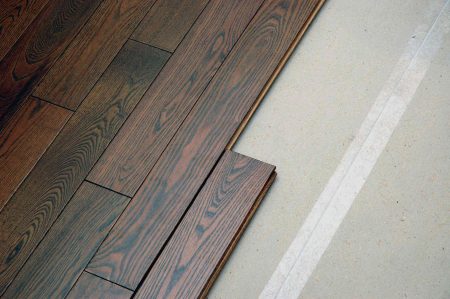Replacing a subfloor under a wall may become necessary if the subfloor is water damaged or no longer structurally sound. A subfloor is the solid base underneath the floor covering that you depend on for the stability of both the floor and walls in a room. Though it’s not the main support system—that’s the work of beams, posts, and joists—it does its fair share of the work. Replacing a subfloor can sometimes escalate into a bigger project, but there are some cases where you can remove parts of the subfloor without having to take down the wall.
Wall and Floor Basics
Walls and floors are interconnected, creating a structurally tight system. From bottom to top, the average home system will look something like this:
- Joist: A floor joist is a long, horizontal piece of wood, usually 2×8 or 2×10 inches, that holds up the flooring.
- Subfloor: The subfloor is nailed to the top of the joist. Often 19/32-inch to 1 1/8-inch thick plywood or OSB, the subfloor might run continuously across the joist, or two sections of subfloor may meet on a joist.
- Underlayment: Some floors have a thin underlayment that helps to smooth the subfloor for the floor covering. Not all floors will have this.
- Floor Covering: The floor covering might be laminate flooring, vinyl tile, luxury vinyl plank, or any other type of floor.
- Bottom Wall Plate: The bottom wall plate is the bottom-most part of the wall. It is usually an 8-foot-long, 2×4 piece. Wall studs are nailed vertically to the bottom wall plate and the wall plate itself is nailed (downward) into the subfloor, with nails even extending into the joist. All items except for the underlayment and floor covering rest under and are nailed to the bottom wall plate.
Removing the Subfloor Under Walls
Removing subfloor while the wall is in place is difficult because the subfloor is trapped under the wall. The process is similar to sliding out a book nailed to the ground while a person is standing on it. It can be done, but it takes some effort and patience. Keep in mind that if you wish to keep the wall in place, you will only be able to remove part of the subfloor—to remove the subfloor across an entire wall, you will need to remove the wall. A safe width to remove is 14 inches since this represents the span between two joists or two studs.
While it may seem tempting to replace the subfloor from underneath if your home has access from the basement to this area, it should always be replaced from the top. Replace a water-damaged or otherwise structurally unsafe subfloor by removing the floor covering and underlayment above it, then cutting out the old subfloor and installing new material.
Before You Begin
At the electric service panel, turn off any circuits that run to the area where you will be removing the subfloor. Shut off any affected water lines. If you have intermediary water shut-offs, shut the water off there. If not, shut off water to the entire house at the main shut-off valve.
What You’ll Need
Equipment / Tools
- Flat pry bar
- Circular saw
- Utility knife
- Oscillating multi-tool and metal blade
- Hand saw
- Drill
- Nail puller
Materials
- Heavy-duty trash bags
- Eye protection
- Ear protection
Instructions
How to Replace a Subfloor Under a Wall
-
Remove the Baseboard
Using the flat pry bar, gently remove the baseboard and any quarter-round trim near where you wish to remove the subfloor. Set these pieces aside.
-
Remove Sections of Drywall
The next step is to remove sections of drywall. It may extend over the floor covering—if this is the case, cut away a section to the required width and about 1-foot high. Place any trash out of the way in a heavy-duty trash bag.
-
Remove the Floor Covering
Remove the floor covering directly above the subfloor that you want to remove. Also, remove a few more inches beyond to give yourself room to work. Some floor coverings will lift off easily, while others will require cutting.
You should be able to lift any laminate flooring and luxury vinyl plank flooring installed parallel to the wall. Self-adhesive vinyl tiles will peel off and sheet vinyl can be pulled back. Ceramic and porcelain tile will need to be broken, plus the thinset mortar that holds it down should be chipped away. Solid hardwood and engineered wood flooring installed parallel to the wall can be pried off, though some boards may end up damaged.
-
Remove Any Underlayment
Some floors have a thin underlayment between the subfloor and the floor covering. For laminate flooring with a foam or felt underlayment, cut away a section with the utility knife. For 1/4-inch luan underlayment board, set the circular saw at the correct depth to cut only into the luan but not any of the materials beneath it.
-
Cut Away the Nails
Attach the metal-cutting blade to the oscillating multi-tool. While wearing eye and hearing protection, turn on the tool and insert the blade under the wall bottom plate. Cut away all nails that run downward from the bottom wall plate.
-
Cut Away the Subfloor
Set the circular saw to the proper depth to cut only the subfloor but none of the materials below the subfloor. Keep in mind that the circular saw cannot cut flush with the wall, so just cut as close as you can get to it—most saws will let you cut as close as an inch or two. Continue with two more cuts with the hand saw along the side of the cut-out square until you reach the wall’s bottom plate.
-
Remove the Subfloor From Under the Wall
If your subfloor is heavily rotted, you may be able to pull back on the remaining section of the subfloor and remove it by hand. If not, attach a 3/4-inch auger bit to the drill and drill to a depth of 3 1/2 inches underneath the wall bottom plate on both sides of the rotted area. The auger bit effectively acts as a saw to cut away at the wood. If the edge of the subfloor rests on the joist, the section of the subfloor should pull out. If not, proceed to the next step.
-
Remove Subfloor From the Other Side (If Necessary)
If the subfloor is a continuous sheet that extends beyond the wall, you will not be able to pull out the section that you are working on. Repeat all of the previous steps on the other side of the wall to free up the subfloor so that you can remove it.
When to Call a Professional
If you need to replace the entire subfloor under an exterior wall or a load-bearing wall, it may be time to hire a professional. Special considerations must be made to prevent the walls from sagging or hanging down while the subfloor is not in place to support them. Smaller sections of the subfloor—up to about 14 inches wide between joists—can be cut out and replaced without needing extra support.
-
How difficult is it to replace subfloor?
Replacing a subfloor is not difficult to learn, but it is a labor-intensive and time-consuming job. DIYers who tackle this project on their own should ensure they’re comfortable with removing and reinstalling flooring, drywall, and trim before beginning.
-
How much does it cost to remove and replace a subfloor?
The cost to replace your subfloor depends on the amount of subfloor that needs to be replaced and the material used. Replacing a standard plywood subfloor typically costs about $1.50 per square foot, or roughly $594 including labor.
-
Do walls sit on top of subfloor?
Yes. Because walls are built on top of a home’s subfloor, replacing the subfloor can sometimes require the walls to be removed.
Read the full article here



